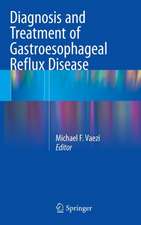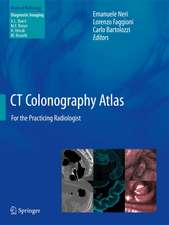Drugs and the Liver: High Risk Patients and Transplantation: Medical Science Symposia Series, cartea 4
Editat de D. Galmarini, L. R. Fassati, Rodolfo Paoletti, S. Sherlocken Limba Engleză Paperback – 29 oct 2012
Din seria Medical Science Symposia Series
- 5%
 Preț: 368.37 lei
Preț: 368.37 lei - 5%
 Preț: 391.79 lei
Preț: 391.79 lei - 5%
 Preț: 657.90 lei
Preț: 657.90 lei - 5%
 Preț: 373.12 lei
Preț: 373.12 lei - 5%
 Preț: 658.63 lei
Preț: 658.63 lei - 5%
 Preț: 374.05 lei
Preț: 374.05 lei - 5%
 Preț: 1102.67 lei
Preț: 1102.67 lei - 5%
 Preț: 646.58 lei
Preț: 646.58 lei - 5%
 Preț: 359.98 lei
Preț: 359.98 lei - 5%
 Preț: 777.55 lei
Preț: 777.55 lei - 5%
 Preț: 707.69 lei
Preț: 707.69 lei - 18%
 Preț: 948.92 lei
Preț: 948.92 lei - 5%
 Preț: 1111.26 lei
Preț: 1111.26 lei - 15%
 Preț: 641.38 lei
Preț: 641.38 lei - 5%
 Preț: 382.26 lei
Preț: 382.26 lei - 5%
 Preț: 375.13 lei
Preț: 375.13 lei - 5%
 Preț: 1426.33 lei
Preț: 1426.33 lei - 5%
 Preț: 1408.60 lei
Preț: 1408.60 lei -
 Preț: 386.99 lei
Preț: 386.99 lei - 5%
 Preț: 377.52 lei
Preț: 377.52 lei - 5%
 Preț: 1101.21 lei
Preț: 1101.21 lei
Preț: 711.15 lei
Preț vechi: 748.59 lei
-5% Nou
Puncte Express: 1067
Preț estimativ în valută:
136.09€ • 141.22$ • 113.75£
136.09€ • 141.22$ • 113.75£
Carte tipărită la comandă
Livrare economică 17-31 martie
Preluare comenzi: 021 569.72.76
Specificații
ISBN-13: 9789401057486
ISBN-10: 9401057486
Pagini: 212
Ilustrații: XXI, 186 p.
Dimensiuni: 160 x 240 x 11 mm
Greutate: 0.3 kg
Ediția:Softcover reprint of the original 1st ed. 1993
Editura: SPRINGER NETHERLANDS
Colecția Springer
Seria Medical Science Symposia Series
Locul publicării:Dordrecht, Netherlands
ISBN-10: 9401057486
Pagini: 212
Ilustrații: XXI, 186 p.
Dimensiuni: 160 x 240 x 11 mm
Greutate: 0.3 kg
Ediția:Softcover reprint of the original 1st ed. 1993
Editura: SPRINGER NETHERLANDS
Colecția Springer
Seria Medical Science Symposia Series
Locul publicării:Dordrecht, Netherlands
Public țintă
ResearchCuprins
1. Risk Assessment in liver transplantation focus on lung function.- 2. Biochemical basis of hepatic ischemic/reperfusion injury.- 3. Donor rating and assessment of pretransplant prognosis by use of the MEGX test.- 4. Significance of cyclosporine pharmacokinetics in liver transplantation.- 5. Cyclosporin toxicity and liver transplantation in high risk patients.- 6. Drug treatment in liver transplanted patients: antihypertensive therapy.- 7. Bacteremia after liver transplantation; few issues in selection of antibiotics for treatment and prophylaxis.- 8. Antiviral drugs.- 9. The use of antiviral drugs in liver transplant patients.- 10. Drugs, fetal liver and reproduction.- 11. Reproduction after transplantation.- 12. Reproduction after liver transplantation for B-virus hepatitis.- 13. 24 hour-hypothermic preservation of rat liver with euro-collins and UW solutions. Comparative evaluation by 31P NMR spectroscopy, biochemical assays and light microscopy.- 14. ATP content during the ischemic period as an indicator of liver viability. A phosphorus-31 NMR study.- 15. Drugs and liver disease.- 16. Liver disease and anticancer drug treatment.- 17. Pharmacokinetics of anticancer agents in patients with impaired liver function.- 18. Pathogenesis and treatment of alcoholic liver disease.- 19. Liver fibrogenesis in chronic viral and alcoholic liver disease.- 20. Hepatocellular carcinoma.- 21. Treatment of iron dependent chronic liver disease.- 22. Liver transplantation for chronic liver disease.- 23. Practical uses of OKT3.- 24. Histopatology of acute liver rejection (ALR) in OKT3 treated patients.- 25. Spin-spin relaxation times as viability parameter of liver transplantation grafts. Investigation on a pig model.- 26. Urinary 6-? hydroxycortisol as a predictor of cyclosporineblood levels.- 27. Elucidation of the metabolic pathways of cyclosporine in vitro by human liver microsomes.- 28. Fine-needle aspiration biopsy and hepatotoxicity of cyclosporin a in orthotopic liver transplantation.- 29. Effect of FK 506 and cyclosporins on model membranes studied by nuclear magnetic resonance spectroscopy.















